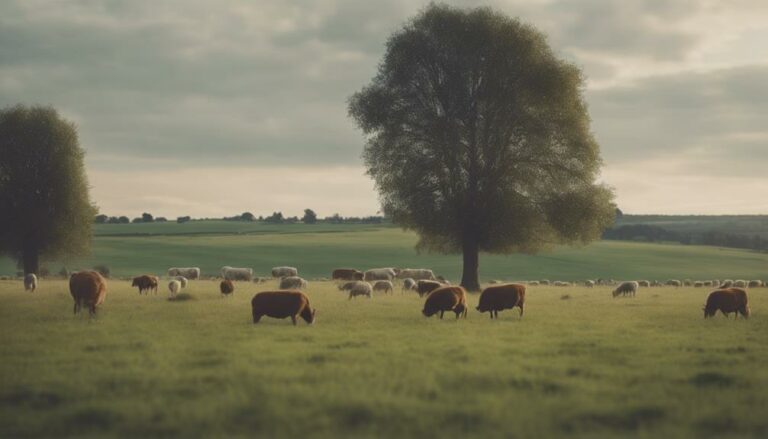Imagine a lush landscape where trees seamlessly intermingle with grazing livestock, creating a harmonious ecosystem that benefits both the environment and the animals. As you consider the benefits of silvopasture versus traditional grazing methods, a deeper exploration into the intricacies of these systems reveals a world of advantages waiting to be discovered. From improved soil health to increased economic viability, the comparison between silvopasture and traditional grazing practices offers a wealth of insights that may reshape your perspective on sustainable land management.
Key Takeaways
- Silvopasture reduces soil erosion and enhances nutrient cycling for improved land sustainability.
- Traditional grazing lacks biodiversity, carbon sequestration, and ecosystem services found in silvopasture systems.
- Silvopasture offers higher economic returns, diversified income streams, and community resilience compared to traditional grazing.
- Livestock in silvopasture benefit from natural shade, diverse forage, and improved welfare, unlike traditional grazing practices.
- Community engagement, local economies, and sustainable land stewardship are promoted by silvopasture over traditional grazing methods.
Environmental Impact: Silvopasture Vs. Traditional Grazing
When comparing the environmental impact of silvopasture to traditional grazing, significant differences emerge regarding soil health, biodiversity, and greenhouse gas emissions. Silvopasture reduces soil erosion and nutrient losses by providing ground cover through trees and shrubs, offering a natural barrier against erosion that traditional grazing lacks. Additionally, silvopasture enhances nutrient cycling within the ecosystem, promoting soil fertility and health. In contrast, traditional grazing practices often lead to soil compaction and reduced water infiltration, impacting overall soil health negatively.
Furthermore, silvopasture contributes to higher carbon sequestration rates, aiding in the removal of greenhouse gases from the atmosphere. This stands in stark contrast to traditional grazing systems, which are known for their higher greenhouse gas emissions. Additionally, silvopasture promotes biodiversity and wildlife habitat preservation by providing a more diverse and complex ecosystem compared to the habitat degradation often associated with traditional grazing methods. When it comes to microclimate regulation and ecosystem services, silvopasture systems excel, offering improved environmental benefits over traditional grazing practices.
Economic Benefits Comparison
Comparing the economic benefits of silvopasture and traditional grazing systems shows significant advantages for those implementing silvopasture practices with regards to profitability and sustainability. Silvopasture offers a 6-14% 10-year Internal Rate of Return (IRR) compared to traditional grazing systems, indicating higher economic returns over the long term.
Here are three key economic benefits of silvopasture:
- Diversified Income Streams: Income from fruits, nuts, or timber harvests in silvopasture systems provides stability during market fluctuations, reducing financial risks and enhancing overall profitability.
- Carbon Credits: Carbon credits from trees in silvopasture systems can further increase economic returns for farmers, tapping into environmental incentives and enhancing the financial viability of the operation.
- Community Livelihoods: Silvopasture creates resilience in operations, reduces dependence on external resources, and improves community livelihoods by fostering sustainable economic practices that benefit both farmers and local residents.
Livestock Health and Well-being
Livestock health and well-being greatly benefit from the natural elements and conditions provided by silvopasture systems, improving their overall welfare and vitality. The presence of natural shade in silvopastures helps reduce heat stress, a significant concern for livestock, especially during hot weather.
Grazing in these systems offers animals a variety of forage options, enhancing their nutrition and overall health. Additionally, the ample space and access to shelter in silvopastures contribute to the animals' comfort and help manage their stress levels effectively.
Silvopasture systems act as a shield, protecting livestock from extreme weather conditions such as heavy rain and intense sun, further promoting their health and welfare. Moreover, the blend of trees and open pasture in silvopastures creates a more natural environment that aligns with the behavioral needs of livestock, supporting their mental and physical health.
Land Management and Sustainability
Silvopasture systems demonstrate a clear advantage in land management sustainability through the strategic integration of trees, forage, and grazing animals, fostering diversified income streams and reducing nitrogen fertilization requirements. This integrated approach offers numerous benefits:
- Improved Soil Quality: The combination of trees, forage, and livestock in silvopasture systems enhances soil health by increasing organic matter content and promoting nutrient cycling, leading to more fertile and resilient soils.
- Enhanced Wildlife Cover: Silvopasture landscapes provide a diverse habitat for various wildlife species due to the presence of trees and diverse vegetation, promoting biodiversity and ecological balance.
- Increased Land Use Efficiency: By combining trees with pasture lands for grazing, silvopasture systems optimize land use, allowing for the sustainable production of both livestock and valuable tree products while minimizing environmental impacts such as soil erosion.
These factors underscore the importance of adopting silvopasture practices for sustainable land management, highlighting the potential for improved ecosystem services and long-term viability in agricultural systems.
Community and Social Considerations
Community engagement is a pivotal aspect of sustainable land management practices, with silvopasture systems demonstrating a significant impact on fostering local economies and enhancing social cohesion. Silvopasture promotes community engagement by providing diversified income opportunities for farmers, supporting local economies, and reducing social conflicts over land use and resource competition compared to traditional grazing practices.
The social benefits of silvopasture extend to improved land stewardship, increased farm resilience, and enhanced community cohesion through shared sustainable practices. In contrast, traditional grazing systems often face challenges related to land degradation and resource depletion, highlighting the need for a more sustainable approach like silvopasture.
Conclusion
To sum up, when comparing silvopasture to traditional grazing practices, the benefits of silvopasture are clear. Not only does it reduce soil erosion and promote biodiversity, but it also offers higher economic returns and improves livestock health.
For example, a study conducted on a silvopasture farm showed a 30% increase in carbon sequestration rates compared to neighboring traditional grazing lands. This data-driven evidence highlights the significant advantages of implementing silvopasture for sustainable land management.

